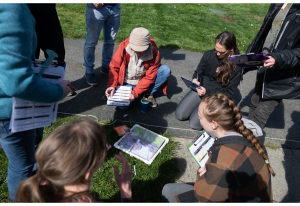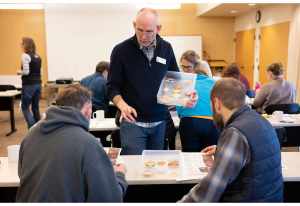WSG Crab Team’s new program makes it easy to get involved in invasive species response
From the Summer 2024 Sea Star
By Alison Lorenz, WSG Science Writer

Volunteers learn Molt Search protocols at a training in Padilla Bay, Washington.
When Lisa Watkins started at WSG as a community science specialist, WSG Crab Team was almost ten years old. The Crab Team monitoring network — a network of several hundred volunteers and partner staff spread all across the state — has spent that decade on the front lines of the European green crab (Carcinus maenas) invasion into Washington’s coastline and inland waterways. Watkins came to the team with a strong background not only in science, but also in managing volunteers to conduct high-quality community-based research. Until the spring of 2023, she and the team were focused on what Crab Team has always done: conducting annual trainings and managing thousands of volunteer hours spread across more than 60 monitoring sites, all in search of invasive green crabs.
But there was, as Watkins notes, “an obvious gap” to be addressed — volunteers had more enthusiasm than time. The existing Crab Team program asks for a substantial commitment from participants, who must attend nearly ten hours of intensive training and commit to visit their assigned trapping sites two consecutive days a month. At the same time, there are many community members who are interested in getting involved at a smaller scale. And as green crab continues to establish and expand into new areas, there are more shorelines that need monitoring.
This combination inspired the creation of Molt Search, a new program launched in partnership with Washington State University (WSU) Extension in May 2023. The program is meant to have a low barrier to entry: volunteers hunt for crab molts, the shells crabs shed as they grow, during timed beach surveys, then submit what they find via a smartphone app called MyCoast. They’re trained with a short and simple, yet comprehensive research protocol. This means that volunteers can rest easy knowing that while tracking molts is simple, their time and effort still produce high-quality data — the type researchers and decision makers can actually use.
The decision to focus on crab molts, rather than live crabs, is similarly motivated. “Through our existing network, volunteers sometimes notice molts before actually trapping a crab,” says Watkins. “By just looking for signs of crab — for molts — it allows the local person to get involved looking for crab without that huge amount of work [to trap them].”
So how is it going so far? As of this writing, Molt Search had already recorded about 400 beach surveys input by more than 120 individual volunteers in different parts of Washington — sufficient, Watkins notes, to give WSG Crab Team and its partners “a really good dataset to work with.” As Crab Team focuses heavily on the early detection of green crab, this new, robust data is all the more important. Molts can serve as a window into all sorts of information about crab activity in an area. They indicate, first of all, that crabs are growing and therefore surviving well. They’re also helping researchers learn more in real time about the connection between where molts are found and where crabs are actually living. Molt Search is even helping to build data about Dungeness crab, whose juvenile phase, Watkins notes, is “remarkably understudied.” Molt data could help managers understand the impacts of green crab on Dungeness during this crucial time, when the two are in direct competition for food and resources.

Molt Search asks volunteers to collect any crustacean molts they find and trains them to distinguish European green crab molts from the molts of native crabs.
The goal of Molt Search and Crab Team’s work, after all, is to generate data that can direct efforts to keep green crab at bay as long as possible. Watkins notes Washington’s Department of Fish and Wildlife responds rapidly to any credible reports of green crab detection. And finding no evidence of green crab in an area is valuable too: it tells state managers that there’s no need to put resources there, at least for now.
Despite prevention measures, green crab populations are slowly spreading. There are simply too many methods of dispersal, from human transportation of ballast water and live seafood to the natural dispersal of crab larvae in ocean currents. The importance of early detection means Molt Searchers will be out on Washington’s shorelines, ready to spot their shedded shells. WSU Extension has taken the lead on getting out into the public and leading training in communities. This train-the-trainer model means that local partners will hopefully have the means to take ownership of their own Molt Search programs, adapting and running them to suit their needs. For example, thanks to Friends of the San Juans hosting local trainings, Molt Search surveys have already been conducted on remote islands not served by ferries. Overall, Watkins is hopeful that the program can play a role in sharing resource managers’ and biologists’ technical expertise with the local communities they’re already serving by, as she puts it, “bringing green crab management work out from behind the curtain.”
“I have a vision that on every shoreline access, every shoreline where folks are welcomed to come, there will be a sign that helps people engage with Molt Search…[so that on] every shoreline, every shorewalker will be combing for signs of green crab,” Watkins says.
As beachwalkers around the state get involved, Watkins hopes, too, that Molt Search can help to get them interested in what happens in our state’s diverse, vibrant waters. “One of my highlights was going on a beach walk with my East Coast mom and finding a way to linger on a sunny day. I said, let’s do this molt search, and ten minutes later, my Atlanta landlocked mom and I were looking at all these crab shells, chit-chatting collecting these shells, and were able to engage with this local fauna in a way that we wouldn’t otherwise,” Watkins shares. “I’m hoping that others are able to do this as well — engage with your local beach or environment.”
###
Washington Sea Grant, based at the University of Washington, helps people and marine life thrive through research, technical expertise and education supporting the responsible use and conservation of coastal ecosystems. The National Sea Grant College Program is part of the National Oceanic and Atmospheric Administration, U.S. Department of Commerce.
Join the conversation: instagram.com/waseagrant and Facebook.com/WaSeaGrant.
AUG
2024